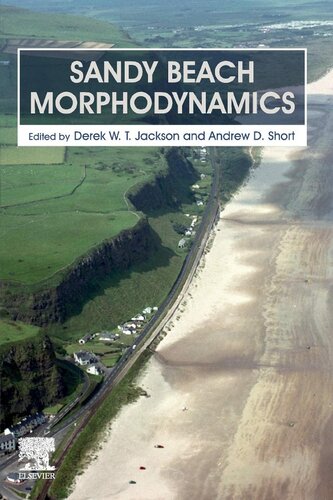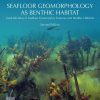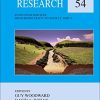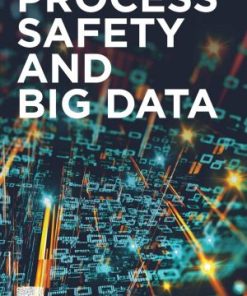Sandy Beach Morphodynamics Form and Process 1st Edition by Derek Jackson, Andrew Short 0081029282 9780081029282
$50.00 Original price was: $50.00.$25.00Current price is: $25.00.
Sandy Beach Morphodynamics: Form and Process 1st Edition by Derek Jackson, Andrew Short – Ebook PDF Instant Download/DeliveryISBN: 0081029282, 9780081029282
Full download Sandy Beach Morphodynamics: Form and Process 1st Edition after payment.

Product details:
ISBN-10 : 0081029282
ISBN-13 : 9780081029282
Author: Derek Jackson, Andrew Short
Sandy beaches represent some of the most dynamic environments on Earth and examining their morphodynamic behaviour over different temporal and spatial scales is challenging, relying on multidisciplinary approaches and techniques. Sandy Beach Morphodynamics brings together the latest research on beach systems and their morphodynamics and the ways in which they are studied in 29 chapters that review the full spectrum of beach morphodynamics. The chapters are written by leading experts in the field and provide introductory level understanding of physical processes and resulting landforms, along with more advanced discussions.
Sandy Beach Morphodynamics: Form and Process 1st Table of contents:
1 – Introduction to beach morphodynamics
Chapter outline
1.1 – Introduction
1.1.1 – Chapter content
1.1.2 – Emerging developments in the study of sandy beaches
References
2 – Beach sand and its origins
Chapter outline
2.1 – Introduction
2.2 – Brief history of provenance studies
2.3 – Sources of beach sand
2.3.1 – Fluvial sand supply
2.3.2 – Production of sand by coastal erosion
2.3.3 – Production of sand by seabed erosion
2.3.4 – Biological production of carbonate sands
2.3.5 – Artificial and nourished beaches
2.4 – Methodological aspects
2.4.1 – Sampling strategies and grain-size analysis
2.4.2 – Hydraulics of beach sand
2.4.3 – Grain size and beach slope relations
2.5 – Conclusions and recommendations
References
3 – Wave climates: deep water to shoaling zone
Chapter outline
3.1 – Introduction
3.2 – Description of a sea state
3.3 – Databases
3.3.1 – Stereo-photography
3.3.2 – Imaging radars
3.3.3 – Laser altimetry
3.3.4 – Radar altimetry
3.4 – Long-term distribution of sea state parameters
3.5 – Extreme value distribution of sea state parameters
3.6 – Non-stationary wave climate
3.7 – Wave atlas
3.8 – Summary
References
4 – Wave behaviour outside the surf zone
Chapter outline
4.1 – General introduction
4.2 – Wave theories
4.2.1 – Deep- and shallow-water linear waves
4.2.2 – Dispersion relation, group speed and phase speed
4.2.3 – Non-linear waves: Stokes, cnoidal and solitary wave theories
4.2.4 – Concept of wave rays
4.3 – Wave shoaling, refraction and diffraction
4.3.1 – Wave shoaling
4.3.2 – Wave refraction
4.3.3 – Wave diffraction
4.3.4 – Measurement and analysis of waves
4.3.4.1 – Measurement
4.3.4.2 – Analysis
4.4 – Wave dissipation
4.4.1 – In deep water (white-capping)
4.4.1.1 – Theory and observations
4.4.1.2 – Measurement techniques
4.4.2 – Bottom friction
4.4.2.1 – Theory
4.4.2.2 – Measurement and analysis
4.5 – Conclusions
References
5 – Tidal modulation
Chapter outline
5.1 – Introduction
5.2 – Tidal processes
5.2.1 – Tidal range and impact on the inshore/breaker wave modulation
5.2.2 – Tidal currents and their impact on inshore circulation
5.3 – Beach morphodynamics
5.3.1 – Effect of tides on beach morphology
5.3.2 – Morphodynamic models of macrotidal beaches and the role of tidal modulation on the beach sta
5.3.3 – Tidal modulation of the RTR and beach type/states
5.4 – Conclusions
References
6 – Breaking waves
Chapter outline
6.1 – Introduction
6.2 – Depth-induced wave breaking in the nearshore
6.2.1 – The break-point location
6.2.2 – Wave breaker types
6.2.3 – Predicting wave breaking
6.3 – Wave breaking in the surf zone
6.3.1 – Measuring waves
6.3.2 – Wave height decay
6.3.3 – Individual wave behaviour
6.3.4 – Breaker types
6.3.5 – Wave speeds
6.3.6 – Wave height distributions of broken waves
6.3.7 – The fraction of broken waves
6.4 – Modelling wave energy dissipation in the surf zone
6.4.1 – Parametric wave energy dissipation models
6.4.2 – Intermediate and shallow water models
6.5 – Conclusions
References
7 – The surf zone
Chapter outline
7.1 – What is the surf zone?
7.2 – Radiation stress and wave set-up
7.2.1 – Radiation stress
7.2.2 – Applications of radiation stress: Wave set-up and set-down
7.3 – Infragravity waves
7.3.1 – What is an infragravity wave?
7.3.2 – Wave reflection
7.3.3 – Types of infragravity waves
7.3.3.1 – Bound infragravity waves
7.3.3.2 – Breakpoint-generated infragravity waves
7.3.3.3 – Edge waves
7.4 – Surf zone currents
7.4.1 – Bed return flow
7.4.1.1 – What goes in, must go out
7.4.1.2 – Stress imbalances drive bed return flow
7.4.1.3 – Sediment transport by bed return flow
7.4.2 – Rip currents
7.4.3 – Longshore currents
7.4.3.1 – Longshore-directed radiation stress drives longshore currents
7.4.3.2 – Predicting longshore currents on planar beaches
7.4.3.3 – Longshore currents on barred beaches
7.4.3.4 – Shear waves and tides modulate longshore currents
7.4.3.5 – Shear waves and sediment transport
7.5 – Summary
References
8 – The swash zone
Chapter outline
8.1 – Introduction: definition of terms and chapter overview
8.2 – Swash zone morphology
8.2.1 – Beach face slope
8.2.2 – Beach berms
8.2.3 – Beach steps
8.2.4 – Beach scarps
8.2.5 – Sediment sorting in the swash zone
8.3 – Shoreline kinematics and swash zone morphodynamics
8.3.1 – Shoreline oscillations driven by standing waves and bores
8.3.2 – Evolving swash spectral signatures under variable incident waves: swash and the beach-state
8.4 – Fluid dynamics, sediment transport and the swash zone profile
8.4.1 – Swash motion
8.4.2 – Influence of beach slope, wave frequency and wave amplitude
8.4.3 – Kinematics
8.4.4 – Models for bed shear stress, boundary layer and sediment transport
8.4.5 – Equilibrium beach profile gradient in the swash zone
8.5 – Swash as a component of coastal inundation
8.5.1 – Wave run-up
8.5.2 – Swash overtopping
8.6 – Concluding remarks
References
9 – Marine sediment transport
Chapter outline
9.1 – Introduction
9.1.1 – Timescales of sediment transport
9.2 – Sediment properties
9.2.1 – Initiation of motion
9.2.2 – Sediment fall velocity
9.3 – Modes of sediment transport
9.3.1 – Suspended load and the advection diffusion approach
9.3.2 – Bedload transport
9.3.2.1 – Shear approach to total bedload
9.3.2.2 – Energetics approach to bedload (Bagnold, Bailard, Bowen line of models)
9.4 – Alongshore and cross-shore sediment transport
9.4.1 – Alongshore sediment transport
9.4.1.1 – Estimating wave-driven alongshore sediment transport
9.4.2 – Cross-shore sediment transport
9.4.2.1 – Mechanisms of cross-shore sediment transport
9.5 – The present state and future challenges in sediment transport modelling
9.6 – Measuring the magnitude of sediment transport along sandy beaches
9.7 – Conclusions and outlook
References
10 – Aeolian (windblown) sand transport over beaches
Chapter outline
10.1 – Introduction
10.2 – Fundamentals of aeolian sand transport
10.3 – Aeolian sand transport models
10.4 – Controls on aeolian sand transport on beaches
10.4.1 – Regional wind climate and geomorphically effective sand transport events
10.4.2 – Beach width and the ‘fetch effect’
10.4.3 – Surface moisture interactions
10.4.4 – Salt and biological crusts
10.4.5 – Surface roughness elements and vegetation
10.4.6 – Slope and topographic effects
10.5 – Summary and conclusions
References
11 – Rip currents
Chapter outline
11.1 – Introduction
11.2 – Rip circulation
11.3 – Rip types
11.3.1 – Hydrodynamically controlled rip currents
11.3.2 – Bathymetrically controlled rip currents
11.3.3 – Boundary-controlled rip currents
11.3.4 – Embayed-cellular rips and mega-rips
11.4 – Spacing and morphology of channel rips
11.5 – Sediment transport in channel rips
11.6 – Morphodynamic evolution of rip systems
11.6.1 – Straight open coasts
11.6.2 – Embayed beaches
11.7 – Role of rips in nearshore, beach and dune interaction
11.8 – Rip forecasting and monitoring
11.9 – Summary
References
12 -From cusps to capes: self-organised shoreline shapes
Chapter outline
12.1 – Introduction
12.2 – Beach cusps
12.3 – Alongshore sandwaves
12.4 – Cuspate capes
12.5 – Discussion
References
13 – Rhythmic patterns in the surfzone
Chapter outline
13.1 – Introduction
13.2 – Patterns
13.2.1 – Shore-parallel sandbars
13.2.2 – Multiple sandbars
13.2.3 – Crescentic sandbars
13.2.3.1 – Observations of crescentic sandbar patterns and behaviours
13.2.3.2 – Physical mechanisms and modelling of crescentic sandbars
13.2.4 – Transverse sandbars
13.3 – Summary and perspectives
References
14 – Mixed sand and gravel beaches
Chapter outline
14.1 – Introduction
14.1.1 – Location and main characteristics
14.1.2 – Brief historical review
14.1.3 – The role of geological factors
14.1.4 – Objectives and scope
14.2 – Characteristics of MSGB
14.2.1 – Steps
14.2.2 – Berms
14.2.3 – Cusps
14.3 – Hydrodynamics of MSGB under short and long waves
14.3.1 – Swash: wave run-up and set-up
14.3.2 – Overtopping and overwashing
14.3.3 – The role of wave reflection
14.3.4 – Groundwater flows: infiltration and exfiltration
14.4 – Morphodynamics of MSGB: sediment erosion and accumulation under multiple spatial and temporal
14.4.1 – Longshore sediment transport on MSGB
14.4.2 – Cross-shore sediment transport at MSGB
14.4.3 – Morphodynamics of storms and natural recovery: evidence from MSGB on the Alborán Sea
14.5 – Discussion and conclusions
14.5.1 – Morphodynamic differences between sandy beaches and MSGB
14.5.2 – Summary and open research questions
References
15 – Sandy beaches in estuaries and bays
Chapter outline
15.1 – Definition of bay and estuary beaches (BEBs)
15.2 – Geological context
15.3 – Oceanographic context
15.3.1 – Ocean waves
15.3.2 – Infragravity waves
15.3.3 – Locally generated waves
15.3.4 – Tidal and fluvial currents
15.4 – Other terms used for BEBs
15.5 – The morphodynamics of sandy beaches in estuaries and bays
15.5.1 – Review
15.5.2 – Summary of BEB morphodynamic characteristics
15.6 – A case study from Botany Bay, SE Australia
15.7 – Emerging concepts and concluding remarks
Acknowledgements
References
16 – Wave-dominated, tide-modified and tide-dominated continuum
Chapter outline
16.1 – Introduction
16.2 – Beach classifications
16.3 – Beach types and states
16.3.1 – Wave-dominated beaches
16.3.2 – Embayed beaches
16.3.3 – Gravel beaches
16.3.4 – Tide-modified beaches
16.3.5 – Tide-dominated beaches
16.3.6 – Beaches fronted by rock flats and reef flats
16.4 – Global and regional controls on beach morphodynamics
16.5 – Conclusion
References
17 – Shallow water wave modelling in the nearshore (SWAN)
Chapter outline
17.1 – The need for wave models
17.1.1 – Classification of wave models
17.1.2 – The new era of morphodynamic wave models
17.2 – Spectral wave models: WAM, WWIII and SWAN
17.2.1 – The use of spectral wave models: from global to local hindcast
17.3 – The SWAN wave model for nearshore environments
17.3.1 – Action balance equation and propagation terms
17.3.2 – Physical processes included in SWAN: source terms
17.3.2.1 – Wind input term
17.3.2.2 – Non-linear interactions: triads and quadruplets
17.3.2.3 – Dissipation
17.3.2.4 – Refraction and diffraction
17.3.2.5 – Other processes
17.4 – Running a SWAN nearshore wave simulation
17.4.1 – Spatial input grids
17.4.1.1 – Bathymetry
17.4.1.2 – Wind field, water levels and bottom friction
17.4.2 – Computational grid and boundary conditions
17.4.2.1 – Boundary conditions
17.4.3 – Outputs grids
17.4.4 – Calibration and validation
17.5 – Summary
References
18 – Reflective–dissipative continuum
Chapter outline
18.1 – Introduction
18.2 – Antecedents to beach morphological and temporal behaviour
18.2.1 – Two-dimensional and three-dimensional beach change approaches
18.2.2 – The Australian wave-dominated Beach Model (ABM) and other beach morphological parameterisat
18.2.3 – Methods and techniques for monitoring-determining beach state and morphology
18.3 – The reflective–dissipative continuum
18.3.1 – Waves and sediment characteristics related to beach classification
18.3.2 – Dissipative beaches
18.3.3 – Intermediate beaches
18.3.4 – Reflective beaches
18.4 – The beach state and/or modal state classification in time and space
18.4.1 – Sequential changes in beach state
18.4.2 – The beach accretion cycle and related morphological configuration
18.4.3 – The beach erosion cycle and the related morphological configuration
18.4.4 – Beach cycle drivers and the antecedent topography
18.5 – Conclusions
References
19 – Shoreline change analysis
Chapter outline
19.1 – Introduction
19.2 – Generation of a shoreline database
19.2.1 – The shoreline
19.2.2 – Shorelines on historical mapping
19.2.3 – Shoreline indicators
19.2.4 – Shorelines from satellite imagery
19.2.5 – Alternative considerations
19.3 – Analytical approach
19.3.1 – Geospatial analysis
19.3.2 – Shoreline change calculations
19.3.3 – Quantification of error and uncertainty
19.3.4 – Multivariate approaches
19.4 – Summary
References
20 – Seasonal imprint on beach morphodynamics
Chapter outline
20.1 – Introduction
20.2 – Seasonality: definition and genesis
20.3 – Morphological proxies to assess seasonality
20.3.1 – Beach erosion
20.3.2 – Beach accretion
20.3.3 – Modelling beach behaviour
20.4 – Seasonal beach imprints
20.4.1 – Imprints on morphology
20.4.2 – Imprints on hydro-sedimentary and aeolian processes
20.5 – Conclusions
References
21 – Long-term shoreline morphodynamics: processes and preservation of environmental signals
Chapter outline
21.1 – Progradational coastal systems
21.2 – Development of regressive records of paleo-environmental change
21.2.1 – Formation of beach and foredune ridges and ridge sets
21.2.2 – Growth of beach- and foredune-ridge plains and preservation of paleo-environmental signals
21.2.3 – Controls on shoreline orientation and growth
21.2.4 – Autogenic and allogenic signals
21.3 – The coastal record of paleo-environmental change: global examples
21.3.1 – Sea-level change
21.3.2 – Sediment fluxes
21.3.3 – Wind and wave climate
21.3.4 – Events
21.3.5 – Secular changes
21.4 – Challenges and recent advances in using the long-term shoreline-change record
21.4.1 – Limitations of the progradational coastal archive
21.4.2 – Recommendations for producing paleo-environmental archives from records of long-term shorel
21.4.3 – Integrating quantitative and process-based understanding of coastal morphodynamics
21.5 – Future outlook for records of long-term shoreline morphodynamics
References
22 – Extreme events: impact and recovery
Chapter outline
22.1 – Introduction
22.2 – Definitions
22.2.1 – Extreme events
22.2.2 – Beach and dune erosion
22.2.3 – Recovery
22.3 – Characterisation of storm impact and recovery
22.3.1 – Storm impacts
22.3.1.1 – Storm impact regimes
22.3.1.2 – Localised three-dimensional impacts
22.3.2 – Beach and dune recovery
22.4 – Example observations from Europe and Australia
22.4.1 – Impact and recovery from the 2013–14 winter along the Atlantic coast of Europe
22.4.2 – Impact and recovery from the 2016 east coast low in SE Australia
22.5 – Future perspectives and knowledge gaps
References
23 – Headland bypassing and overpassing: form, processes and applications
Chapter outline
23.1 – Definitions and literature review
23.2 – Major controls and driving forces
23.2.1 – Geomorphological constraints
23.2.2 – Sediment characteristics and availability
23.2.3 – Physical forcing
23.2.3.1 – Beach connectivity, bypassing index and headland bypassing rate equation
23.3 – Classification and conceptual models
23.3.1 – Headland overpassing
23.3.2 – Headland bypassing swash-surf zone
23.3.3 – Headland bypassing surfzone-nearshore
23.3.4 – Headland bypassing cross embayment
23.4 – Investigating HB&O
23.4.1 – Visual observation
23.4.2 – Remote-sensing
23.4.3 – Sediment-based methods
23.4.3.1 – Surface sediment samples and cores
23.4.3.2 – Sediment trapping
23.4.3.3 – Sediment tracing
23.4.4 – Morphological measurements
23.4.4.1 – Sub-bottom and GPR profilers
23.4.5 – Instrumentation
23.4.6 – Numerical modelling
23.4.7 – Advantages and disadvantages of methods
23.5 – HB&O and building with nature concept
23.6 – Summary
Further Reading
References
24 – Mechanisms and timescales of beach rotation
Chapter outline
24.1 – Introduction
24.2 – Drivers and mechanisms of beach rotation
24.2.1 – Longshore coherent response
24.2.2 – Combined cross-shore and longshore response
24.2.3 – Nearshore morphological dynamics
24.3 – Timescales of beach rotation
24.3.1 – Short-term
24.3.2 – Medium-term
24.3.3 – Long-term
24.4 – Beach rotation in the context of global change and human action
24.4.1 – Sea-level rise
24.4.2 – Wave climate
24.4.3 – Coastal modification
24.5 – Summary
Further Readings
References
25 – Coastal sediment compartments, wave climate and centennial-scale sediment budget
Chapter outline
25.1 – Introduction
25.2 – Coastal morphology, sediment transport paths and compartmentalisation
25.3 – Wave climate and the sediment valve concept
25.4 – Sediment budget determination
25.5 – Case study on centennial scale sediment budget analysis
25.5.1 – Historical bathymetric surveys and shoreline maps
25.5.2 – Geohistorical morpho-sedimentary archive
25.5.3 – Data-model evaluation of sand transport
25.6 – Outstanding research problems on defining coastal stability and projecting future coasts
Acknowledgements
References
26 – Global beach database
Chapter outline
26.1 – Introduction
26.2 – Remote sensing techniques and validation
26.2.1 – Sandy beach detection
26.2.2 – Shoreline detection methods
26.2.3 – Accuracy and limitations
26.2.3.1 – Accuracy
26.2.3.2 – Limitations
26.3 – Global beach database
26.3.1 – Global occurrence of sandy beaches
26.3.2 – Global sandy beach dynamics
26.4 – Hotspots of retreating and prograding beaches
26.5 – Quantifying local scale changes
26.6 – Outlook
References
27 – Beach and nearshore monitoring techniques
Chapter outline
27.1 – Introduction
27.2 – Monitoring design
27.2.1 – Why monitoring?
27.2.2 – Monitoring design
27.2.2.1 – Monitoring design principles
27.2.2.2 – Spatial and temporal scales
27.2.2.3 – Spatial and temporal resolutions
27.2.2.4 – Budget
27.2.3 – Coastal measurements in context: multidisciplinary monitoring
27.2.4 – Common pitfalls and how to avoid them
27.3 – Monitoring equipment and parameters
27.3.1 – In situ
1 – Global Navigation Satellite System (GNSS)
2 – Wave buoy
3 – Pressure transducer
4 – Drifters/drogues
5 – Optical backscatter sensor (OBS)
Acoustic instruments
6,7 – Single-beam echosounder/underwater altimeter
8 – Multibeam echosounder
9 – Acoustic Doppler velocimeter (ADV)
10 – Acoustic Doppler current profiler (ADCP)
11 – Acoustic backscatter sensor (ABS)
27.3.2 – Remote sensing
12 – Laser scanning
13 – Photography
14 – Video monitoring
15 – Radar
27.3.3 – Samplers
16 – Water sampler
Sediment traps
17 – Underwater
18 – Above water
19 – Grab
20 – Core
27.3.4 – Particle size analysis
27.3.4.1 – Calipers
27.3.4.2 – Sieve
27.3.4.3 – Laser granulometer
27.4 – Data management
27.4.1 – Role of data management
27.4.2 – Good data
27.4.3 – Data management plan
27.4.4 – Data management system
27.4.5 – Sharing data
27.4.6 – Publishing data
27.5 – Future perspective
Acknowledgements
References
28 – Machine learning and coastal processes
Chapter outline
28.1 – Introduction
28.1.1 – What is ‘machine learning’?
28.1.2 – Differences between machine learning and other modelling approaches
28.2 – Machine learning for modelling coastal processes
28.2.1 – k-nearest neighbours
28.2.2 – Decision trees and random forests
28.2.3 – Bayesian networks
28.2.4 – Neural networks
28.2.5 – Support vector machines
28.2.6 – Other machine learning algorithms
28.3 – Machine learning guidelines
28.3.1 – Typical machine learning workflow and semantics
28.3.2 – Tools for machine learning
28.3.3 – Preparing data, feature engineering and feature selection
28.3.4 – Model selection
28.3.5 – Model evaluation
28.3.6 – Example application
28.4 – The future of machine learning in coastal processes
References
29 – Future challenges in beach management as contested spaces
Chapter outline
29.1 – Introduction
29.2 – Beach dynamics and coastal management
29.3 – Shoreline boundary shifts
29.4 – Managing the challenges of landward translation of beaches
29.5 – Beach management in the future—some examples
29.6 – Conclusion
People also search for Sandy Beach Morphodynamics: Form and Process 1st:
are sandy beaches natural
quiet sandy beaches near me
beach morphodynamics
morphodynamics definition
a sandy shore
Tags: Sandy Beach, Morphodynamics, Form, Process, Derek Jackson, Andrew Short
You may also like…
Politics & Philosophy - Politics
Marxism, Pedagogy, and the General Intellect: Beyond the Knowledge Economy 1st Edition
Children's Books - Science Fiction & Fantasy
Romance
Uncategorized
Engineering
Politics & Philosophy - Anthropology
Ebook












